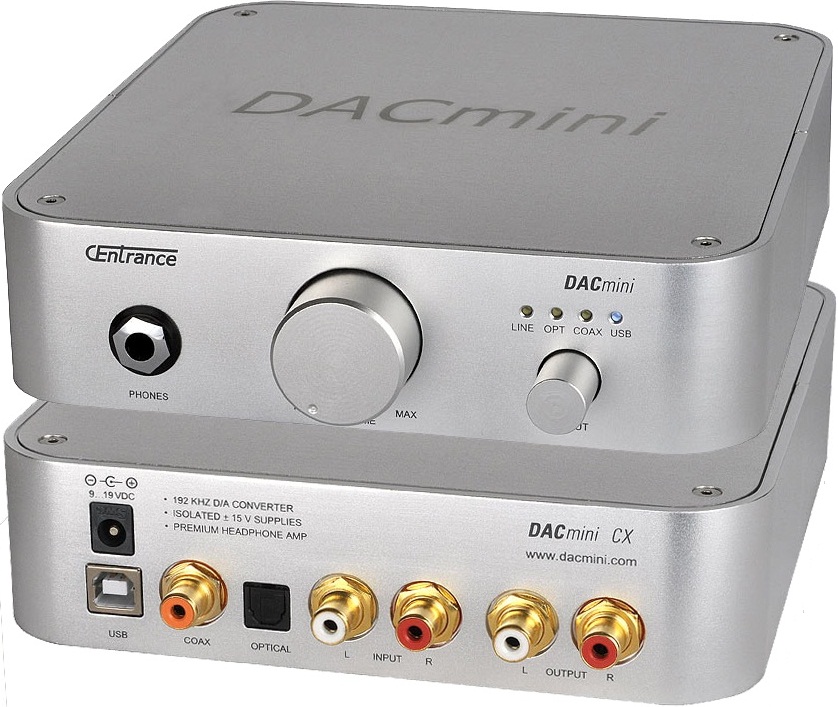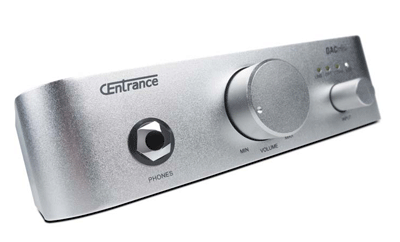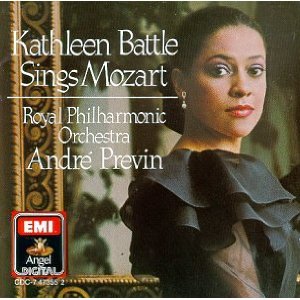The CEntrance DACmini
| The CEntrance DACmini |
| Enter CEntrance |
|
|
|
October, 2011 |

If you want to know where things are headed, look toward integration. Biology and physics, computers and phones, and most importantly for mankind, chocolate and peanut butter. I’m speaking here of Reese’s of course—both Pieces and Cups. But this is not TheChocolateOutlook.com—it’s Stereotimes.com
So what’s the audio upshot of this confluence? Well it can only be the recent explosion of DAC/headphone amps/preamps and all manner of combinations and permutations in between. Behold the future. Yes—we’re apparently tired of multi-box systems. Our long-beleaguered spouses have won – and now they don’t have to take it anymore!
I’ve heard my share of headphone amps and my share of DACS, but I confess, the CEntrance (pronounced SEH-ntrance) DACmini is the first such combinatorial ‘product o’ the future’ I have been privy to. Billing itself as a sufficient though not necessary companion to Apple’s redoubtable Mac mini, the CEntrance DACmini not only rhymes with its intended stable mate—it certainly looks to be blessed by Steve Jobs’ minions. In short—it’s drinking the Cupertino Cool Aid. To wit, it comes complete with everything, save the de rigueur Black mock turtle and jeans and is made to fit neatly and preciously either beneath or above Apple’s beautiful mini number-cruncher. (Too bad Harry the Hanukkah fairy passed me over this year and I don’t gots one)-Well—there’s always next year. I’ll just pray even harder this time.
No matter—I have a black Macbook with a 500GB hard drive (how big is yours?!) loaded with AIFF and lossless music files ripped from the thick-with-cobwebs bowels of my CD collection along with an equally sexy and incredibly convenient Squeezebox Touch for streaming purposes—itself ‘Apped’ out with the awesome 320 kbps Spotify and good ol’ Pandora
N.B.: The latter product, my Squeezebox Touch, is not Steve Jobs approved—but it should be. I’m hereby putting her up for canonization as an honorary Apple product. Like Steve’s toys, it’s sleek and of-a-piece and employs a pretty intuitive user interface. Plus – you know all those reviews you’ve read that say something like “well—the Squeezebox Touch sounds pretty good but not great,” or those reviews that end with “I nominate the Squeezebox Touch for a solid class D recommendation” or what have you? Well they’re, ummm… what’s the audiophile equivalent of … dead wrong!!?
Firstly, because who earthly cares how the Squeezebox Touch itself sounds?!! We’re audiophiles damn it, and you KNOW we’re all gonna use external DACs and 700 dollar wires anyway!!
And secondarily, the little SB Touch sounds GREAT in its own right. Class D mein Tuchas!! And I’ve by now tried to spruce it up with many and sundry DACs, so I should know. It trails only a touch in dynamic vim and vigor and perhaps also lacks a trifle of image depth and bass definition/depth by way of comparison with superb digital. More importantly, it loses out nearly not at all to the bigger boys in any measure of tonality and ultimate musical involvement. In fact, the standalone Touch is a tone- meister. Oh – and did I mention you’ll still be huntin’ for just the ‘right’ CD by the time I’m halfway through Wagner’s ring cycle?
So “go ahead (gravel voice—lots of sub-par whisky)—make my day. “ I defy you to put your 3 or 4 kilobuck CD player up against my 24/92 ready SB Touch- especially when it’s plugged into a great DAC that costs even one third what your fancy soon-to-be-dug-only-by-archaeologists CD player does.

A DAC like, say, the one in the CEntrance…
CEntrance our hero stage right (speaking softly and in a melodious manner as if singing mournfully- though not in a melancholy sense)
According to a review of his gear I read recently on the interwebs, genius amp designer Nelson Pass hates cutesy review subtitles (see above). But that’s why he’s a brilliant engineer and not a reviewer. Of course– I couldn’t design an amp to save my life. I even have trouble finding the power button on some; especially his.
In any case, speaking of Papa Pass, before I received my review sample I read somewhere or other (internet post maybe?) that the CEntrance headphone amp supposedly sounds kinda like Nelson Pass’s amps do—clean and clear but non-fatiguing. Well, having owned a few Pass amps in my day, including most recently the wonderful space-heating Aleph 3, I’d have to agree with that assessment minus maybe the extra bit of sonic warmth that great amp has.
Via its AdaptiWaveTM USB, coax or line inputs, the DACmini was quite revealing of recorded detail but never verged on edgy– except of course, with ‘edgy’ recordings themselves. Good concert hall string recordings of all types were redolent, piano top registers were properly bell-like and ‘pingy’ and as with a live performance, I soon learned there was no need to wince when powerhouses like Joan Sutherland let loose with crazy high notes and such in the finale of showy warhorses such as Sempre Libera [The Art of the Prima Donna on Decca] etc. With AIFF and Losslesss files running from the Macbook (itunes or Decibel) via USB to the CEntrance, any and all of my well-recorded soprano harem sounded beautiful; clean, clear and grain n’ edge-free. I should add I found no loss of top end sparkle or definition- just no added edge or bothersome brightness.
 More so than usual, Kathleen Battle’s voice, always a touchstone for me, had the all the requisite silver thread running through the tone without a hint of bite or grain. As a matter of fact I would say the CEntrance majors on lack of grain and grittiness and Ms. Battle’s recording of Mozart arias [Kathleen Battle Sings Mozart on EMI] had me smiling and reveling in the absolute purity of sound.
More so than usual, Kathleen Battle’s voice, always a touchstone for me, had the all the requisite silver thread running through the tone without a hint of bite or grain. As a matter of fact I would say the CEntrance majors on lack of grain and grittiness and Ms. Battle’s recording of Mozart arias [Kathleen Battle Sings Mozart on EMI] had me smiling and reveling in the absolute purity of sound.
In my long-time fave recording of Donizetti’s opera L’elisir d’amore on DG, Ms. Battle joins another ‘larger’ touchstone of mine, the big man himself, Luciano Pavarotti (God rest his soul). Here via the CEntrance, the full measure of Pavarotti’s metal overtones and resonances could be appreciated right alongside all of Kathy Battle’s silver. In short, listening to opera and vocal recitals over the CEntrance DACmini was sheer delight. No jacket or ticket required. Just sit back, relax and enjoy.
Speaking of enjoyment, I’m moved to speak of the change in listening habits the arrival of the CEntrance brought about. As I say, the CEntrance DACmini is the first such ‘combination’ product I’ve had in house, and before her, I hadn’t known the carnal pleasures of a high-end audio system in bed… or at the kitchen table… or in my favorite easy chair. Yeah—I get around.
Yeah I have headphone amps and yeah I have DACs—but its so friggin’ hard to bring all that crap around the house enmasse! The wiring alone is a nightmare with all the separate plugs and digital cables and interconnects and extension cables.
The CEntrance in this sense is positively a pleasure. Here in one small, sleek, light weight box, we have superb ‘ouch-free’ digital conversion along with first-rate head amp performance. Nice touches include a step-less volume attenuator so it’s kittens’ play to find juuuuuuust the right volume on any recording and the fact that the CEntrance barely gets warm at all is an boon to its Snuggle-ability Factor (SF). Ever try snuggling up to a class A Burson or a Pass amp? Ouch! Second degree burns hurt. Yup—with the CEntrance you can get up close and personal—no asbestos needed.
Safety concerns addressed, this brings us to the only part of this review the better part of you, dear readership, are likely to care about… comparisons.
This Vs. That
In this corner, the CEntrance head amp/DAC. And in the far corner, weighing in at precisely the same weight and designed by precisely the same person and/or people—the umm….. CEntrance head amp/DAC.
Yes—it’s the always exciting USB vs. Coax fight and let me tell you, in all but the most critical listening the two inputs sounded, well… remarkably similar! Well—remarkably equally enjoyable really.
Wasn’t expecting that? Neither was I! See, I had read all this stuff about how USB really sucks and is a computery thing for transmission of computery things by computery types and Asynchronous this and Adapti that and there are only certain magical USB DACs designed by leprechauns in black forests that can…
Well it was all pretty meaningless to me after a good hour or two switching back and forth on the fly between the USB input of the CEntrance (AdaptiWaveTM based—a technical methodology for jitter reduction/elimination I am certainly not qualified or interested enough to get into here or anywhere) and the Coax input. In fact, I started my ‘switching sessions’ all eager and afire with the passion of innocence and naïve youth, and due to the mind-numbing sonic similarities between the two input types, either by turns began to wonder what so and so would sound like singing such and such instead of who I was listening to sing it now—or fell asleep on my rug cradled in the soft velvety clasp of my ALO-cabled Sennheiser’s. In short—initially I thought I might have heard the tiniest sliver more air, space and detail with certain recordings into the CEntrance via coax, but musically, via Decibel’s software on my Macbook, the USB’s version of events was compelling enough that I mostly lost interest and even had trouble telling the two inputs apart when ‘blindfolding’ myself and swapping randomly back and forth during a particular piece of music. I’d forget whether this was the USB or the Coax etc. and fall back to sleep… And this was with the stock USB cable as supplied!
Comparisons with other digital equipment on hand were instructive, though ultimately somewhat boring. By this I mean that once a product is sufficiently ‘musical’—whatever that particular phrase my mean to you in your world—then things become a matter of taste rather than ‘good better best.’ How pointless to argue Pavarotti vs. Bjorling vs. Tucker vs. Paul Potts (threw that last one in as a discriminatory joke—Note: opera buffs are the only ones laughing—that’s how you tell who we are. All of ‘em were born and built to sing and do so consummately within the bounds of their own particular oeuvre and aptitude.
The CEntrance DAC was good enough. I wouldn’t kick it out of bed—and didn’t. In fact—I invited it in (see above). It was not quite as dynamic or as generous with its bass as the Burson HA-160D (on hand for upcoming review), nor was the CEntrance quite as detailed and ‘spacey’ or as limitless up top as the wonderful Neko Audio D100 Mk 2 (on generous loan as a digital reference from Wesley Miaw). I actually asked to borrow the Neko back from Wesley for comparison purposes and now in Mk 2 formulation, it remains among the the most evolved digital pieces I have had the pleasure of enjoying. But these differences were extremely small, and if not an unpaid superstar on-line reviewer, I would barely notice or care.
In sum, I definitely wouldn’t shed tears if someone broke in and stole the Burson and the Neko, leaving me only the CEntrance. Considering the company, I think that speaks volumes as to how musically enjoyable the CEntrance is.
It is certainly a more convenient thing than either of these other two boxes, and to be frank, its portability, step-less attenuation (which I much prefer to stepped—apologies to my mates over at Burson), cool runnings (also a great John Candy movie about bobsledding), and relative sonic equivalence of USB and Coax inputs made it the more oft used piece when I just wanted to do some private listening.
Just stay on my wing, Cougar—I’ll take you all the way home. -Tom Cruise as Maverick from the movie Top Gun
If you don’t do much headphone listening, you should buy the CEntrance. On the other hand, if you listen to headphones a lot, you should also buy the CEntrance. What’s this? Marketing boiler plate? Look at it this way—the DACmini is physically un-obtrusive, silent and cool enough never to be noticed except when you want to plug into it, and it is sonically and functionally on par with or superior to any sanely priced head amp I have heard in the past, from Grados to HeadRooms to iCute Beyonds etc. It’s also extremely solidly built, lightweight and relatively portable, and does nothing sonically wrong. I have no doubt one of those amazing Liquid Fire or Woo multi-kilobuck headamps might do this or that better than the CEntrance (haven’t heard ‘em), much as the Burson does macrodynamics and pace just a bit better. Still, it’s tough to argue with completeness. Also, I feel the sonic quality of the USB input in the CEntrance is all but unmatched—easily competing with its own coax input– sometimes, with a select few vocal recordings, even causing me to imagine it might have very slightly less fine grain than the USB input on the superb Burson HA-160D (review pending).
In short, they’ve got this AdaptiWaveTM USB thing down. So, unless maybe you’re one of those guys with the fifteen different headphones, a one of a kind Lizard’s Lightning Woo Woo Wild 5 SE head amp, and a dedicated, acoustically sound listening-closet replete with lifetime ‘appreciation’ award from headphone.com, I’d certainly make a play for the CEntrance DACmini. Even more certainly if USB is a major pleasure source for you.
Me? I’m waiting till CEntrance comes out with the Mk II model. You know—the one with the huge external power supply, a few glowing hot tubes up top, etc. That’ll make it as hot, bulky, expensive and inconvenient as everything else out there. They’ll sell a ton!
I bid you peace.
![]()
Specifications:
Digital specs
Resolution: 24-bit (Also supports 16-bit)
Sample Rate: USB: Up to 96kHz, S/PDIF: Up to 192 kHz
Interface: USB1.1 or 2.0, driverless
Local clock: 10 ppm precision, unmeasurable jitter
Compatibility: Any computer running Mac, PC, or Linux
Analog Specs
Nominal Output level: +6.0dBV (RCA outputs)
Frequency Response: 20Hz…40kHz; +0.0dB / -0.1dB (Line or Digital inputs)
S/N Ratio: (A-wght): 144dB (Line inputs); 113dB (Digital inputs)
THD+N: 0.00022% (Line inputs); 0.001% (Digital inputs)
Crosstalk: -128dB (Line inputs); 118dB (Digital inputs)
Output Impedance:25 Ohms (Line output); 10 Ohm (Headphone output) **
Output Power: 1.5W (total), drives 32…600 Ohm headphones
Max Output level*
+13.5dBV (32 Ohms load)
+18.6dBV (300 Ohms load)
+19.0dBV (600 Ohms load)
Price: $795.00 USA
Contact:
CEntrance, Inc.
8817 Mango Ave
Morton Grove, IL
60053 USA
Voice 847-581-0500
Fax 847-581-0901
Office Hours 9 am to 5 pm, CST
Information info@centrance.com
Sales sales@centrance.com
![]()
Don’t forget to bookmark us! (CTRL-SHFT-D)
Stereo Times Masthead
Publisher/Founder
Clement Perry
Editor
Dave Thomas
Senior Editors
Frank Alles, Mike Girardi, Key Kim, Russell Lichter, Terry London, Moreno Mitchell, Paul Szabady, Bill Wells, Mike Wright, Stephen Yan, and Rob Dockery
Current Contributors
David Abramson, Tim Barrall, Dave Allison, Ron Cook, Lewis Dardick, Dan Secula, Don Shaulis, Greg Simmons, Eric Teh, Greg Voth, Richard Willie, Ed Van Winkle, and Rob Dockery
Music Reviewers:
Carlos Sanchez, John Jonczyk, John Sprung and Russell Lichter
Site Management Clement Perry
Ad Designer: Martin Perry




Be the first to comment on: The CEntrance DACmini